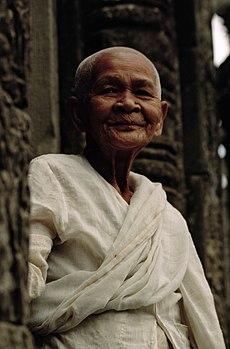After the 13th century Theravada Buddhism became the state religion of Cambodia.
King Jayavarman VII had sent his son Tamalinda to Sri Lanka to be ordained as a Buddhist monk and study Theravada Buddhism according to the Pali scriptural traditions. Tamalinda then returned to Cambodia and promoted Buddhist traditions according to the Theravada training he had received, galvanizing and energizing the long-standing Theravada presence that had existed throughout the Angkor empire for centuries.
During the time Tamalinda studied at the famous Mahavihara Monastery in Sri Lanka (1180–1190), a new dynamic type of Theravada Buddhism was being preached as the "true faith" in Sri Lanka. This form of Buddhism was somewhat militant and highly disciplined in reaction to the wars with the Tamil that nearly destroyed Buddhism in Sri Lanka in the 9th and 10th centuries. As Theravada Buddhism struggled for survival in Sri Lanka, it developed a resiliency that generated a renaissance throughout the Buddhist world, and would eventually spread across Burma, Chang Mai, the Mon kingdoms, Lana, Sukothai, Laos, and Cambodia.[7]
In the 13th century, wandering missionaries from the Mon-Khmer-speaking parts of Siam, Burma, Cambodia, and Sri Lanka played an important part in this process.
When Prince Tamalinda returned after ten years of ordination, he was a Thera, a senior monk, capable of administering ordination into this vigorous Theravada lineage, which insisted on orthodoxy and rejected Mahayana "innovations" such as tantric practices.
The mass conversion of Khmer society to Theravada Buddhism amounted to a nonviolent revolution every all level of society. All monumental building projects that had characterized the Angkor empire came to a sudden end. Scholars struggle to account for this sudden and inexplicable transformation of Khmer civilization.
Theravada Buddhism succeeded because it was inclusive and universal in its outreach, recruiting the disciples and monks from not only the elites and court, but also in the villages and among the peasants, enhancing its popularity among the Khmer folk.
"Their message succeeded because it provided a meaningful way of relating to the world for many who had been marginal to the classical civilizations or who had been seriously affected by the disruption of the classical civilizations in the 13th and 14th centuries."[7]
Journalist Elizabeth Becker explained the phenomenon: "Cambodians were ripe for conversion. The political integrity and morality of the kingdom were thrown into question at the time, and Cambodians converted en masse to this new faith that offered social tranquility without striving for material gain or power. The modest Buddhist bonzes were a welcome change from the arrogant and wealthy priests of the kings. The new Buddhists dressed in simple saffron robes. They possessed a sense of responsibility for all, not just the nobility. Eventually they became as revered as the devaraja, who in turn became a Theravada Buddhist himself as patron of the faith."[8]
Other scholars suggest that the classical Angkor Empire collapsed from desertion from within and assault from without, from growing external threats and assaults from Siam and Vietnam which were both in ascendancy at the time.
"The post-Angkor period saw the dramatic rise of the Pali Theravada tradition in Southeast Asia and concomitant decline of the Brahmanic and Mahayana Buddhist religious traditions. A 1423 Thai account of a mission to Sri Lanka mentions eight Khmer monks who again brought orthodox Mahavihara sect of Singhalese order to Kampuchea. This particular event belied, however, the profound societal shift that was taking place from priestly class structure to a village-based monastic system in Theravada lands. While adhering to the monastic discipline, monks developed their wats, or temple-monasteries, not only into moral religious but also education, social-service, and cultural centers for the people. Wats became the main source of learning and popular education. Early western explorers, settlers, and missionaries reported widespread literacy among the male populations of Burma, Thailand, Kampuchea, Laos, and Vietnam. Until the 19th century, literacy rates exceeded those of Europe in most if not all Theravada lands. In Kampuchea, Buddhism became the transmitter of Khmer language and culture."[3]
The Theravada revolution was therefor a grassroots movement of the Khmer people rejecting some of the oppressive practices of the god-king religion of Hinduism and Mahayana Buddhism.
With the rise of Siam in the west and Vietnam in the east, the classical Angkor empire disappeared and the beginning of present-day Cambodia began. The center of government began to migrate away from Angkor to a more central location in the center of Cambodia, in the regions near present-day Phnom Penh.
Cambodia became from this time forward a Theravada Buddhist nation. "Theravada Buddhism, unlike almost all the previous religions of the country, its doctrines were not imposed from above but were preached to the people. It was simple, required no expensive priesthood or temples and little ceremonial. Its missionaries practiced austerity, solitude, humility, and poverty. Their example and their direct contact with the people started to undermine the old state religion and the monastery which rested upon it. Theravada Buddhism remained the great belief and comfort of the Khmer people until 1975."[9]
Zhou Daguan, a Chinese visitor to the Royal Court of Cambodia at this time wrote of the presence of Theravada Buddhist monks in the latter days of Angkor.
Zhou Daguan was an emissary from the court of Timur Khan, Emperor of China. Daguan lived in Angkor Thom for one year 1296-7 and wrote a small book about his observations in which he described Theravada monks with shaved heads, yellow robes and one shoulder bare, walking barefoot throughout Cambodia. Their temples were simple, he said, containing one image of Sakyamuni Buddha. The image was draped in yellow cloth.
The Theravada monks ate meat or fish but did not drink wine. They ate only one meal a day. They did not cook in the temple, but lived on alms food.

No comments:
Post a Comment